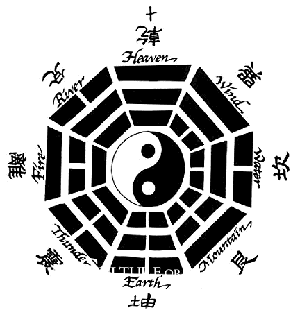To overlay the Bagua on your home or work floor plan, stand at the threshold of the door facing inside and hold the diagram so that the blue, black, and gray guas are closest to you. Pretend you are drawing a line straight across the front of the home from the door: That would be the line at the bottom of this color chart.
Sometimes it is a bit more challenging to overlay theBaguaonto a space that is oddly shaped.
The Baguais always aligned with the wall containing the front door or main entrance to any living/working space, so it can be applied to the entire house or building or to a specific room. You can also apply theBaguato the main entry point of any exterior space, such as an entire property, a backyard or a small garden.
The Picture of the Ultimate and the Eight Diagrams
The picture is a composite of the Ultimate and the Eight Diagrams, and can still be found in some Chinesetemples. The picture of the Ultimate consists of a black and a white fish -- also called theyin and yangfish. The picture of the Eight Diagrams is an octagon formed from eight combinations of three whole or broken lines.

qian, sky
kun, earth
zhen, thunder
xun, wind
kan, water
li, fire
gen, mountain
dui, lake
According to legend, the picture was created by Fuxi, an ancient Chinese sage. It is written in the ancient bookZhou Yi(The Zhou Book of Changes): "Changes originate in the Ultimate; from the Ultimate issue the two spheres. From the two spheres issue the four elements, and from the four elements the eight diagrams". That was the basic theory of the Ultimate, giving rise to the eight diagrams. By the Ultimate, the ancient meant the origin of all things and creatures. The philosopher Zhu Xi (1130-1200) of the Southern Song Dynastysaid, "The Ultimate is the way of all things in heaven and earth". The two spheres refer to heaven and earth, or yin (feminine, negative) and yang (masculine, positive). The four elements are metal, wood, water and fire, which are omnipresent. The eight diagrams symbolize the eight natural phenomena: sky, earth, thunder, wind, water, fire, mountain and lake. So, the picture represented the ancient Chinese early knowledge of the universe, which contained a simple dialectical materialist point of view.
What's more interesting is the picture of the Eight Diagrams, which is formed of yao (lines), namely, the yangyao (male line, whole line written as __) and the yinyao (female line, a broken line written as - -.) The two forms are opposites and they form the eight combinations.
By taking two of the lines or doubling them, 64 combinations can be made.
It has been suggested that the German mathematician Wilhelm von Leibuiz (1646-1716) was inspired by the Chinese Eight Diagrams to create the binary system. If this was true, then the Chinese picture of the Ultimate and the Eight Diagrams made some historic contribution to modern computer science.